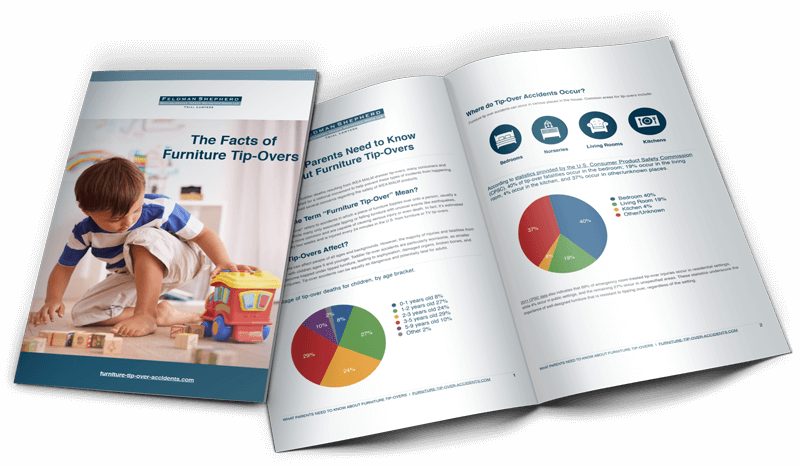On May 24, 2017, a father entered the bedroom of his two-year-old son, Jozef, to check on him as he took his nap. He encountered a sight that no parent should ever see: an IKEA MALM three-drawer dresser had fallen on top of his son, pinning him between the drawers. Despite the father’s frantic efforts to perform CPR and get medical help, Jozef was pronounced dead later that same day.
The tragic experience of Jozef’s family, unfortunately, is not unique.
- February 2014: Two-year old Curren Collas was crushed to death at his Pennsylvania home by the tip-over of an IKEA MALM dresser in his bedroom.
- June 2014: Camden Ellis, a 23-month-old boy from Washington State, died as the result of a tip-over of a three-drawer MALM dresser in his bedroom.
- February 2016: Two-year-old Ted McGee perished in Minnesota when a six-drawer MALM dresser fell on top of him in his bedroom.
Over the years, there have also been at least five other deaths, dozens of injuries and well over a hundred reports of IKEA near-miss furniture tip-overs.
How Can We Protect Children from IKEA Furniture Tip-Overs?
Our firm was retained by the four families identified above, who suffered what is probably the most painful loss anyone can endure. The Collas, Ellis and McGee families settled their claims against IKEA in December of 2016. Jozef’s case was just recently filed. The tragic deaths of these children, together with our clients’ wish that no other family should have to grieve as they had, quickly led us to recognize a broader responsibility we had in this litigation. Sometimes cases demand not only our best efforts to obtain compensation for our clients, but impose on us a mission to help protect others we don’t know and don’t represent. Here, we quickly learned that the popular and innocent-appearing chests and dressers sold by IKEA were in fact unstable and unsafe, and presented a danger in any home environment where they were accessible to children. Our objective was clear: we needed to shine a spotlight on the dangers of these IKEA products, and make every effort to get them off the market and out of people’s homes.
Of course, not everyone shared our belief about the hazards of MALM dressers and other IKEA furniture lines. In a disturbingly familiar “blame the victim” response, IKEA and even some members of the public argued that the reported deaths and injuries, however sad, were the responsibility of the parents of the children. If consumers would simply take the simple step of bolting their furniture to a wall, they suggested, tip-overs could easily be prevented. Thus, IKEA’s initial response after the two child deaths in 2014 was not to recall their chests and dressers, but instead to offer a “Repair Program,” in which consumers could request a “wall anchoring repair kit” which essentially consisted of screws and plastic anchors. But the IKEA remedy was neither practicable nor effective: the kit was not useful for the millions of consumers who were not permitted to make holes in apartments they rented, or had baseboard heating which prevented the dresser from being positioned flush against the wall, or who had masonry walls that could not be penetrated without special power tools. Others discovered to their chagrin that screwing plastic anchors into drywall was simply ineffective at preventing tip-overs. And consumers don’t buy dressers to keep permanently affixed to one location forever; in the real world, they move from room to room and house to house.
While all of these reasons contributed to the failure of the Repair Program (only about one in one hundred purchasers of MALM dressers requested the repair kit), there was another, more fundamental reason why the program was such a dismal failure: the truth is that most people simply do not think about bolting dressers, chests and other furniture to the wall. An inexpensive, free-standing MALM dresser does not look like a dangerous product, and it is not intuitive for consumers to think about it toppling over. Nor should they have to. Other furniture sold in America is built to meet the national (but voluntary) testing standards for safety and stability. ASTM standard F2057, entitled “Standard Safety Specification For Clothing Storage Units,” sets forth a testing procedure in which a 50 pound weight is placed over the lip of a fully opened drawer, the idea being to replicate the weight of a small child climbing on the furniture. There is no question that chests and drawers which meet the standard are significantly more resistant to tip-overs. Why did IKEA furniture have such an alarming rate of tip-over injuries and deaths? Because IKEA had consistently refused to design and build its furniture to meet the ASTM standard.
Does IKEA Children’s Furniture Meet Safety Standards?
As trial lawyers, we know that the impetus for product safety arises not only from regulations and standards, but from products liability law. The law of Pennsylvania and most other states requires that products be safe for their intended and expected use. We know that most manufacturers have been able to accommodate the higher level of safety demanded by products liability laws, while preserving the function and affordability of their products. There is simply no room in our marketplace for products which are, by design, unstable and unsafe right out of the box.
As more tip-overs and toddler deaths and injuries continued to be reported, consumer organizations, elected representatives, grieving parents and most notably the Consumer Product Safety Commission agreed that too many children had died. They coalesced around the principle that furniture which can easily tip over has no place in our homes, particularly when accessible to children. Thus, Consumers Union (the parent of Consumer Reports), Kids In Danger and the Consumer Federation of America questioned why IKEA was permitted to sell a product that failed to meet accepted industry standards, and called for a national recall of the non-compliant chests and dressers. Senators Casey, Klobuchar, Blumenfeld and Rep. Schakowsky introduced legislation to make voluntary minimum stability standards mandatory. Some parents who had suffered the loss of a child developed websites and spoke to the media to increase awareness of the hazards of IKEA furniture. The CPSC listened, and following negotiations with IKEA’s lawyers, achieved what, at that time, was the best outcome possible: the recall of 29 million MALM and other model chests and dressers sold by IKEA in the United States (and nearly 7 million more sold in Canada), with refunds for all who return them. Equally important was the professed commitment by IKEA executives to redesign its dressers to meet standards for safety and stability going forward.
Unfortunately, though, the recall conducted by IKEA was inadequately publicized, and millions of the unsafe older model dressers still remain in the homes of consumers around the country. One of those dressers was the dresser that fell on Jozef. His parents never received notice of the recall and were unaware of the dresser’s propensity to tip over.
How Can Attorneys Prevent IKEA Furniture Deaths?
It is difficult to quantify the impact of lawsuits in helping to achieve an outcome that will almost certainly save lives and prevent injuries in the future. It is at least possible that IKEA would have independently concluded that its furniture was a danger to children, and would have introduced new, safer designs on its own. I only know that at Feldman Shepherd, we are proud to be part of a coalition that helps to get unsafe products out of American homes so that children truly can be safe in their own bedrooms.
As we litigate Jozef’s tragic case, we will continue our work to ensure that every parent with an older model IKEA chest or dresser in their home is made aware of the danger. Doing so is our responsibility, and indeed one of our highest callings, as attorneys.


